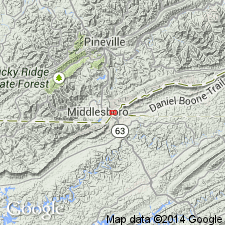
- Usage in publication:
-
- Pinnacle Overlook Member*
- Modifications:
-
- Named
- Dominant lithology:
-
- Sandstone
- AAPG geologic province:
-
- Appalachian basin
Summary:
Named as lowest member of Lee Formation. Named for the Pinnacle, a scenic overlook formed by the rock on northeast side of Cumberland Gap, Bell Co., southeastern KY. Previously called lower tongue of Lee Formation. Forms cliffs. Consists of very light gray, thick-bedded, well-sorted, fine- to medium-grained, quartzose sandstone in lower and upper parts, and of white to very light gray, massive, conglomeratic, quartzose sandstone in middle part. Cross-bedding is conspicuously developed throughout. Thickness ranges from 230 ft at the Pinnacle to 360 ft about 2 mi to the northeast. From this point, member thins in a broad arc to form a northwestward-protruding lobe. Along most of outcrop belt, upper contact grades abruptly into greenish- or reddish-gray shale of upper tongue of Pennington Formation. At southwest end of outcrop belt, is overlain by Chadwell Member of Lee Formation. Basal contact ranges from sharp to gradational with upper tongue of Pennington Formation. Age is Mississippian.
Source: GNU records (USGS DDS-6; Reston GNULEX).
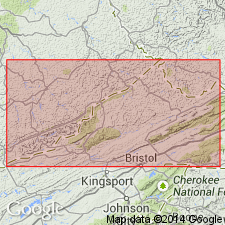
- Usage in publication:
-
- Pinnacle Overlook Member*
- Modifications:
-
- Areal extent
- AAPG geologic province:
-
- Appalachian basin
Summary:
Pinnacle Overlook Member extended to VA from KY in the Butcher Knob and Chadwell Gap sections, Lee Co., VA, as shown on correlation diagram (fig. 2). [Equivalent sandstone tongues appear at same horizon farther to northeast, but diagram doesn't indicate how far to northeast Pinnacle Overlook is known.]
Source: GNU records (USGS DDS-6; Reston GNULEX).
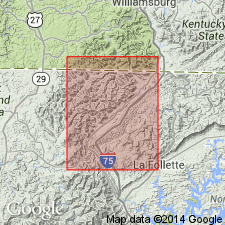
- Usage in publication:
-
- Pinnacle Overlook Member*
- Modifications:
-
- Areal extent
- Age modified
- AAPG geologic province:
-
- Appalachian basin
Summary:
Pinnacle Overlook Member extended into TN from KY as shown in map of Jellico West quad (plate 2). Age of member refined from Mississippian to Late Mississippian as shown on correlation chart of plate 2.
Source: GNU records (USGS DDS-6; Reston GNULEX).
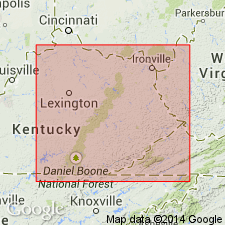
- Usage in publication:
-
- Pinnacle Overlook Member*
- Modifications:
-
- Areal extent
- AAPG geologic province:
-
- Appalachian basin
Summary:
At its type area, Pinnacle Overlook Member overlies marine Little Stone Gap Member of Pennington Formation, and underlies an unnamed marine unit of the Pennington that consists of greenish-gray and grayish-red shale containing a thin bed of fossiliferous limestone. Both fossiliferous marine units are discontinuous. Near type area, Pinnacle Overlook Member is locally overlain by quartzose sandstone of Chadwell Member. Age is Late Mississippian.
Source: GNU records (USGS DDS-6; Reston GNULEX).
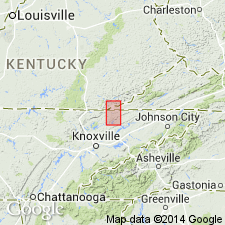
- Usage in publication:
-
- Pinnacle Overlook Member
- Modifications:
-
- Revised
- AAPG geologic province:
-
- Appalachian basin
Summary:
Pinnacle Overlook Member, a 230-ft resistant sandstone, "properly belongs in the Mississippian Pennington Formation." Usage here agrees with that of Vanover (1989: Eastern KY Univ. M.S. thesis). According to authors, Englund's (1964) interpretation of a Pinnacle Overlook Member of the Lee Formation that intertongues with the upper member of the Pennington was based on a misidentification of the Chadwell Member of the Lee along the ridge at Tri-State-Peak. In this report Pennington Formation unconformably underlies the Chadwell Member of the Lee Formation and the Lee is entirely Pennsylvanian.
Source: GNU records (USGS DDS-6; Reston GNULEX).
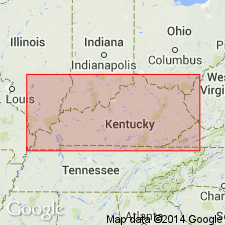
- Usage in publication:
-
- Pinnacle Overlook Sandstone
- Modifications:
-
- Revised
- AAPG geologic province:
-
- Appalachian basin
Summary:
Pinnacle Overlook Sandstone Member of the Lee Formation may be equivalent to the Princeton Sandstone. The Pinnacle Overlook is herein removed from the Lee Formation (abandoned) and formally assigned at formation rank to the Pennington Group. Occurs along the Cumberland overthrust sheet.
Source: GNU records (USGS DDS-6; Reston GNULEX).
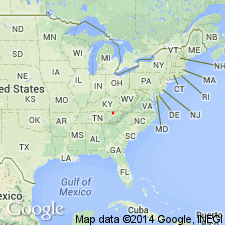
- Usage in publication:
-
- Pinnacle Overlook Member*
- Modifications:
-
- Revised
- AAPG geologic province:
-
- Appalachian basin
Summary:
In pilot bore section, contact between upper member of Newman Formation and lower member of overlying Pennington Formation was identified as contact between lower member of Pennington and overlying Pinnacle Overlook Member of Lee Formation by Vanover and others (1989, Itinerary, Day 2-Pilot bore traverse, IN Dean, C.S., and Moshier, S.O., eds., Cumberland Mountain: the inside story: Geological Survey of Kentucky Field Trip Guidebook, p. 24-30), by Vanover (1989, Pilot tunnel stratigraphy, IN Dean, C.S., and Moshier, S.O., eds., Cumberland Mountain: the inside story: Geological Survey of Kentucky Field Trip Guidebook, p. 39-43), and by Watson and Ettensohn (1991, Nature and origin of the Mississippian-Pennsylvanian unconformity in the Cumberland Gap area [abs.]: Geological Society of America Abstracts with Programs, [no volume given], p. 146). Although Newman-Pennington contact is gradational and therefore may not always be placed at same position everywhere, basal bed of Pennington, as well as that of Hinton Formation is resistant quartzose ripple-bedded Stony Gap Member [of Hinton Formation] that is also known as lower member of Pennington Formation. A key to this correlation is Little Stone Gap Member of Hinton, a calcareous siltstone containing marine fossils, which is also present at base of upper member of Pennington. This fossil bed, also known as Avis Limestone of Reger (1926), was traced southeastward across VA to Cumberland Gap. On northeast side of Cumberland Gap, Little Stone Gap Member and part of underlying Stony Gap Member are truncated at base of overlying Pinnacle Overlook Member of the Lee. This relationship has been depicted on map of Middlesboro South quadrangle (Englund, 1964, U.S. Geological Survey Geologic Quadrangle Map GQ-301) and other reports. Therefore, Pinnacle Overlook Member is above rather than below Little Stone Gap Member in pilot bore section where it consists of two conglomeratic quartzose units, a common feature of the member especially where it decreases in thickness. These conglomeratic sandstones were identified as Chadwell Member of Lee by Vanover and others (1989) and Vanover (1989).
Source: GNU records (USGS DDS-6; Reston GNULEX).
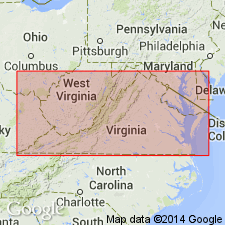
- Usage in publication:
-
- Pinnacle Overlook Member
- Modifications:
-
- Areal extent
- AAPG geologic province:
-
- Appalachian basin
Summary:
Outcrop of the Pinnacle Overlook Member of the Lee Formation is limited to extreme southwestern Lee Co., VA, from Cumberland Gap northeast to White Rocks. Thickness increases from 230 ft at the type locality to 360 ft approximately 2 mi northeast of Cumberland Gap. Consists of thick-bedded, well-sorted, fine- to medium-grained quartzarenite in the lower and upper parts. Middle part contains massive, conglomeratic, quartzose sandstone. Conformably underlies an unnamed member. Intertongues with the Tallery Sandstone Member of the Hinton Formation to the northeast. Age is Late Mississippian (Chesterian).
Source: GNU records (USGS DDS-6; Reston GNULEX).
For more information, please contact Nancy Stamm, Geologic Names Committee Secretary.
Asterisk (*) indicates published by U.S. Geological Survey authors.
"No current usage" (†) implies that a name has been abandoned or has fallen into disuse. Former usage and, if known, replacement name given in parentheses ( ).
Slash (/) indicates name conflicts with nomenclatural guidelines (CSN, 1933; ACSN, 1961, 1970; NACSN, 1983, 2005, 2021). May be explained within brackets ([ ]).

